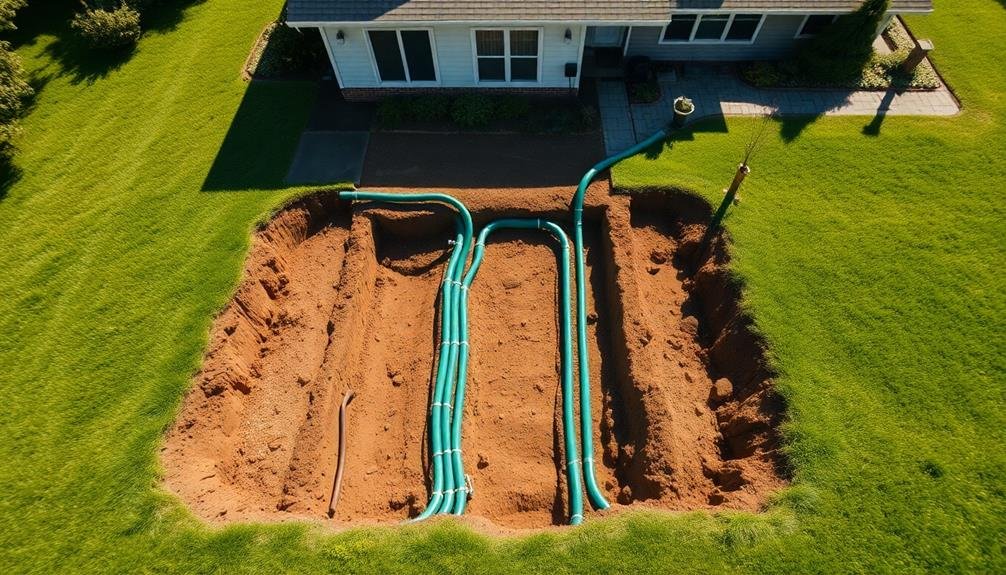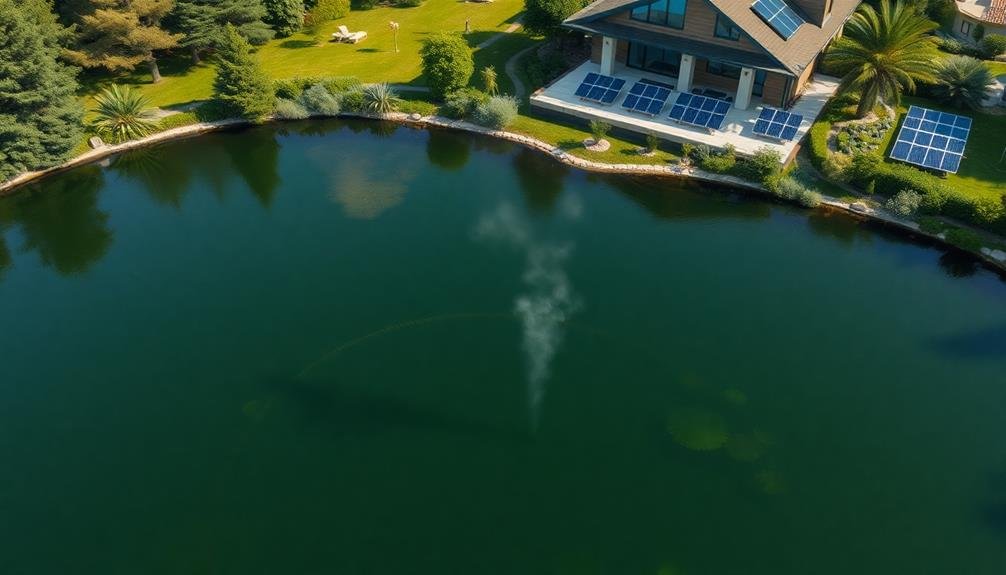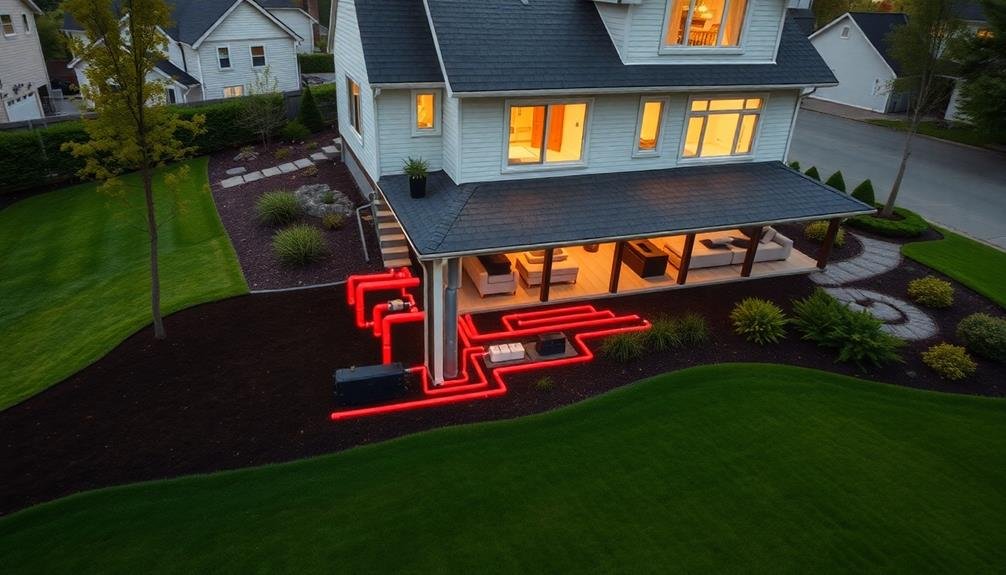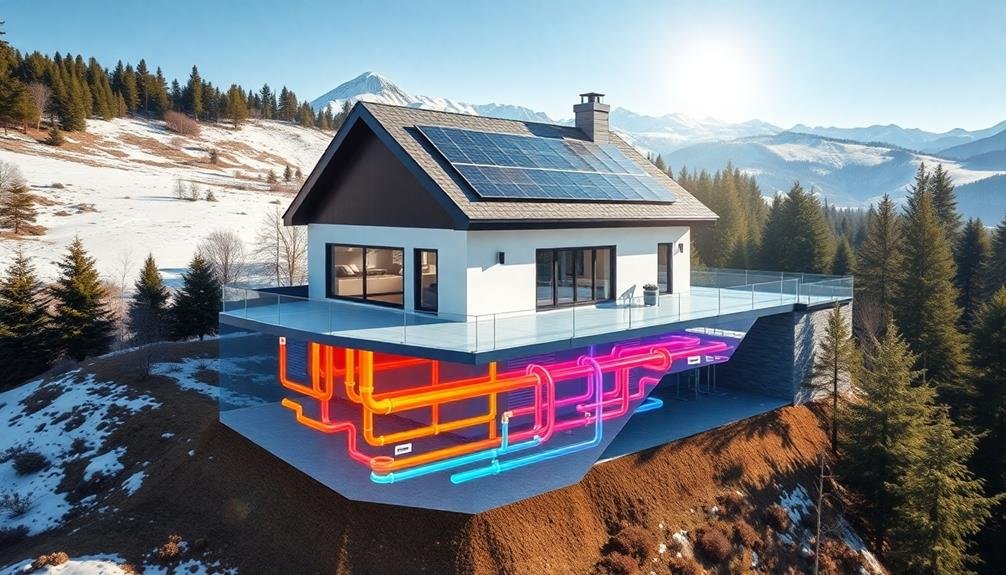You'll boost your home's energy efficiency and reduce utility costs by installing one of these five geothermal loop systems. Horizontal loops are cost-effective for large properties, while vertical loops work well in limited spaces. If you have a pond, a pond loop system offers high efficiency with lower installation costs. Open loop systems directly use groundwater, providing excellent performance in suitable locations. For maximum flexibility, hybrid loops combine closed and open loop features. Each system has unique advantages, so you'll need to evaluate your property's characteristics and local conditions to determine the best fit. Exploring these options further will help you make an informed decision for your home.
Horizontal Loop Systems

Many homeowners choose horizontal loop systems as their geothermal heating and cooling solution. These systems are ideal if you have ample land available, typically requiring 1,500 to 3,000 square feet of space.
Horizontal loops are installed in trenches dug 4 to 6 feet deep, making them less expensive to install than vertical systems.
You'll find that horizontal loops come in two main configurations: single-pipe and slinky. Single-pipe systems use long, straight pipes laid out in parallel trenches. Slinky systems coil the pipes, reducing the amount of land needed but requiring more piping overall. Both types efficiently transfer heat between your home and the ground.
When considering a horizontal loop system, you'll need to factor in your property's layout and soil conditions. These systems work best in areas with moist, conductive soil.
They're less suitable for rocky terrain or regions with extreme temperature fluctuations. You should also consider potential landscaping disruptions during installation, though the area can be fully restored afterward.
Despite these considerations, horizontal loops remain a popular and cost-effective choice for many homeowners seeking geothermal efficiency.
Vertical Loop Systems
While horizontal systems are great for spacious properties, vertical loop systems offer an excellent alternative for homeowners with limited land. These systems consist of pipes drilled deep into the ground, typically 100 to 400 feet, in a series of boreholes. You'll need fewer pipes than in a horizontal system, making vertical loops ideal for smaller lots or areas with rocky soil.
Vertical loops are highly efficient due to their depth, where ground temperatures remain stable year-round. They're less affected by seasonal temperature fluctuations, ensuring consistent performance. You'll also benefit from minimal landscape disruption during installation, as the drilling process is localized.
However, vertical systems come with higher upfront costs due to specialized drilling equipment and expertise required. They're also more challenging to repair if issues arise, given their depth. Despite these drawbacks, vertical loops are often the go-to choice for urban or suburban homes with limited outdoor space.
When considering a vertical loop system, consult with a geothermal expert to assess your property's suitability. They'll evaluate factors like soil composition, water table depth, and local regulations to determine the best design for your home.
Pond Loop Systems

For homeowners with access to a pond or lake, pond loop systems offer a unique and efficient geothermal option. These systems utilize the consistent temperature of water bodies to exchange heat with your home. You'll need a pond that's at least 8 feet deep and covers a sufficient surface area to accommodate the required piping.
Pond loop systems consist of coiled piping submerged in the water. The coils are typically made of high-density polyethylene and filled with an antifreeze solution. As the fluid circulates through the loops, it absorbs heat from the water in winter and releases heat in summer. This process is more efficient than air-source heat pumps because water has a higher heat capacity than air.
You'll benefit from lower installation costs compared to vertical or horizontal loops since there's no need for extensive excavation. Pond loops also require less piping than other systems.
However, you must guarantee that your pond maintains a stable water level and doesn't freeze solid in winter. Regular maintenance is essential to prevent algae growth or damage from aquatic life.
With proper installation and care, pond loop systems can provide efficient heating and cooling for your home while utilizing a natural resource on your property.
Open Loop Systems
Unlike closed loop systems, open loop geothermal systems directly utilize groundwater as a heat exchange medium. These systems pump water from a well or other source, circulate it through the heat pump, and then discharge it back into the ground or a surface body of water.
Open loop systems are often more efficient than closed loop systems, as they benefit from the constant temperature of groundwater. They're typically less expensive to install but require a reliable water source with good quality and flow rate. You'll need to take into account local regulations regarding groundwater use and discharge when planning an open loop system.
Here's a comparison of open loop system types:
| System Type | Water Source | Discharge Method |
|---|---|---|
| Single Well | Aquifer | Surface water body |
| Standing Column | Deep well | Same well |
| Two Well | Aquifer | Separate injection well |
Maintenance is essential for open loop systems. You'll need to regularly clean or replace filters and heat exchangers to prevent scaling and fouling. While these systems can be highly effective, they're not suitable for all locations due to water quality and availability concerns. Consider consulting a geothermal expert to determine if an open loop system is right for your home.
Hybrid Loop Systems

Hybrid loop systems combine the best features of both closed and open loop geothermal setups. These systems offer flexibility and efficiency by utilizing both ground and water sources for heat exchange.
You'll find that hybrid systems are particularly useful when you have limited land space or when groundwater conditions aren't ideal for a full open loop system.
In a typical hybrid setup, you'll have a closed loop portion buried in the ground and an open loop section that taps into a water source. This combination allows you to benefit from the stability of ground temperatures and the high heat transfer rates of water.
You can expect improved performance during peak heating and cooling seasons, as the system can switch between or combine both sources as needed.
When you're considering a hybrid system, you'll need to assess your property's characteristics carefully. Factors like available land, water quality, and local regulations will influence the design.
While hybrid systems can be more complex to install, they often provide superior efficiency and adaptability compared to single-source systems.
You'll likely see reduced operating costs and a smaller environmental footprint over time.
Frequently Asked Questions
How Long Does a Geothermal Loop System Typically Last?
You'll be pleased to know that geothermal loop systems typically last 25 to 50 years. They're incredibly durable and require minimal maintenance. With proper care, you can expect your system to provide efficient heating and cooling for decades.
What Maintenance Is Required for Geothermal Loop Systems?
You'll find geothermal loop systems require minimal maintenance. You should have a professional inspect the system annually, check fluid levels, and clean filters. It's also wise to monitor your energy bills for any unexpected changes in efficiency.
Can Geothermal Loop Systems Be Installed in Existing Homes?
Yes, you can install geothermal loop systems in existing homes. You'll need to assess your property's space and soil conditions. It's more challenging than new construction, but retrofitting is possible with proper planning and professional installation.
How Noisy Are Geothermal Heat Pumps Compared to Traditional HVAC Systems?
You'll find geothermal heat pumps much quieter than traditional HVAC systems. They don't have outdoor units, so there's no noisy compressor outside. Inside, they're typically as quiet as your refrigerator, making them barely noticeable.
Are There Government Incentives or Tax Credits for Installing Geothermal Systems?
Yes, you'll find various government incentives for installing geothermal systems. You can claim a federal tax credit of up to 30% of the installation cost. Many states offer additional rebates or tax incentives, so check your local options.
In Summary
You've now explored the five best geothermal loop systems for home efficiency. Whether you choose horizontal, vertical, pond, open, or hybrid loops, you'll benefit from this eco-friendly heating and cooling solution. Consider your property's size, soil conditions, and local regulations when deciding. Don't forget to consult with a geothermal expert to determine the best system for your home. By investing in geothermal energy, you're taking a significant step towards a more sustainable and cost-effective future.





Leave a Reply